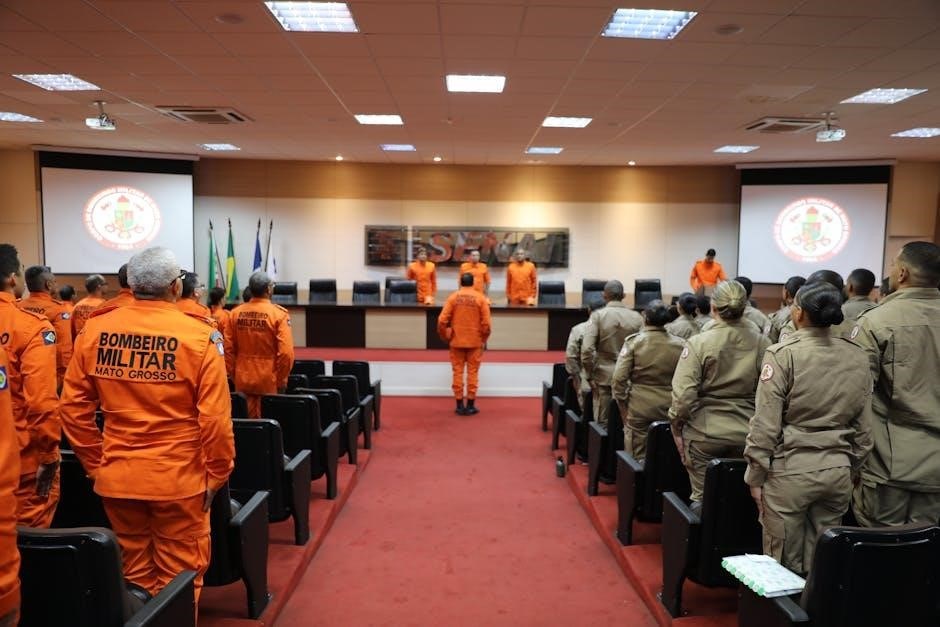Leadership styles are distinct patterns of behavior that influence organizational success. They shape how leaders motivate, communicate, and make decisions, adapting to various situations and team needs effectively.
Definition and Overview of Leadership Styles
Leadership styles refer to the distinct approaches leaders use to guide, motivate, and manage their teams. Each style reflects a unique combination of behaviors, attitudes, and decision-making patterns. They influence how leaders interact with followers, set goals, and respond to challenges. Leadership styles are shaped by personal traits, organizational culture, and situational demands. Common styles include autocratic, democratic, transformational, and laissez-faire, among others. Understanding these styles helps leaders adapt their strategies to achieve organizational success and foster a positive work environment. Effective leadership styles balance authority, communication, and empathy, enabling leaders to inspire and empower their teams effectively.
Key Characteristics of Effective Leadership
Effective leadership is characterized by a combination of traits that enable leaders to inspire, guide, and empower their teams. Key characteristics include visionary thinking, which involves setting clear goals and aligning them with organizational objectives. Strong communication skills are essential for conveying ideas, fostering collaboration, and ensuring understanding. Emotional intelligence helps leaders navigate interpersonal dynamics, build trust, and manage conflicts. Adaptability allows leaders to respond to changing circumstances and challenges effectively. Decisiveness and accountability are critical for making informed choices and taking responsibility for outcomes. Finally, empathy and resilience enable leaders to support their teams and maintain composure under pressure. These traits collectively define effective leadership and drive organizational success.

Main Leadership Styles
Leadership styles represent distinct behavior patterns that leaders adopt to influence and guide their teams toward achieving organizational goals, adapting to various contexts and challenges effectively.
Autocratic Leadership Style
The autocratic leadership style is characterized by centralized decision-making, where the leader holds complete authority and control over all aspects of the organization. In this style, leaders make decisions without input from team members, relying solely on their own judgment and expertise. Communication is typically one-way, with leaders providing clear instructions and expecting compliance. This style is often effective in crisis situations or when quick decisions are necessary. However, it can lead to low employee morale, reduced creativity, and higher turnover rates due to the lack of involvement and autonomy for team members. Autocratic leadership is commonly seen in hierarchical or traditional organizational structures.

Democratic Leadership Style
The democratic leadership style emphasizes collaboration and shared decision-making. Leaders involve their team members in key decisions, fostering a sense of ownership and accountability. This approach encourages open communication, creativity, and innovation, as employees feel valued and empowered. Democratic leaders act as facilitators, guiding discussions and ensuring diverse perspectives are considered. While this style can lead to more informed and accepted decisions, it may slow down decision-making processes. It is most effective in environments where teamwork, trust, and employee engagement are prioritized. However, it can be less practical in situations requiring swift action or when team members lack the necessary expertise or experience to contribute meaningfully to decisions.
Transformational Leadership Style
The transformational leadership style focuses on inspiring and motivating teams to achieve a shared vision. Leaders with this style encourage innovation, creativity, and growth by fostering a sense of purpose and meaning. They often lead by example, demonstrating a commitment to the organization’s goals and values. This approach emphasizes empowering employees to think critically and take ownership of their work. Transformational leaders use strategies such as idealized influence, intellectual stimulation, individualized consideration, and inspirational motivation to engage their teams. This style is particularly effective in driving organizational change, improving morale, and fostering a culture of continuous improvement. However, it requires strong communication and emotional intelligence to connect with team members effectively.
Transactional Leadership Style
The transactional leadership style is based on a clear exchange between leaders and followers. Leaders set specific goals, provide rewards for achieving them, and use penalties for underperformance. This approach relies on structured processes and clear expectations to maintain order and efficiency. Transactional leaders focus on task-oriented behaviors, ensuring compliance with established procedures. They often use contingent rewards, such as bonuses or promotions, to motivate employees. While effective in stable environments, this style may lack the inspirational aspects of other leadership approaches. It is particularly useful in situations requiring consistency and adherence to rules, but it may not foster innovation or long-term engagement.

Laissez-Faire Leadership Style
The laissez-faire leadership style is characterized by minimal interference in team operations. Leaders provide employees with autonomy to make decisions and complete tasks independently. This approach fosters creativity, innovation, and self-motivation among team members. It is most effective in environments with skilled, experienced, and self-driven individuals who require little supervision. However, the lack of clear direction and accountability can lead to disorganization and missed deadlines in less disciplined teams. Leaders adopting this style trust their team’s capabilities and focus on providing resources rather than direct guidance. While it promotes flexibility, it may result in a lack of structure, making it less suitable for teams needing strong oversight or clear communication.
Charismatic Leadership Style
The charismatic leadership style is centered around a leader’s personality, charm, and ability to inspire others. Charismatic leaders possess strong communication skills, emotional intelligence, and a vision that motivates followers to achieve shared goals. This style emphasizes building trust and emotional connections with team members, fostering loyalty and commitment; Charismatic leaders often lead by example, demonstrating confidence and passion, which can drive innovation and creativity within an organization. However, this style can be challenging to sustain, as it heavily relies on the leader’s personal traits. Without proper structure, it may lead to overdependence on the leader and potential neglect of operational details. Despite this, charismatic leadership is highly effective in inspiring and energizing teams to pursue ambitious objectives.
Servant Leadership Style
The servant leadership style emphasizes a leader’s role as a servant to their team, prioritizing the well-being, growth, and empowerment of employees. This approach focuses on understanding and addressing the needs of team members, fostering a collaborative and supportive work environment. Servant leaders encourage open communication, active listening, and shared decision-making, which builds trust and strengthens relationships. They prioritize ethical behavior, empathy, and humility, creating a culture of mutual respect and accountability. By empowering others, servant leaders aim to enhance job satisfaction, productivity, and overall organizational success. This style is particularly effective in fostering a sense of community and shared purpose, leading to long-term sustainability and employee engagement.
Strategic Leadership Style

The strategic leadership style focuses on aligning an organization’s vision with its operational goals, ensuring long-term success. Strategic leaders are visionary thinkers who inspire and motivate their teams to achieve overarching objectives. They excel at analyzing market trends, identifying opportunities, and managing risks. This style emphasizes the ability to make informed, forward-thinking decisions while maintaining flexibility to adapt to changing circumstances. Strategic leaders foster innovation, encourage collaboration, and empower employees to contribute to the organization’s mission. By leveraging tools like SWOT analysis and scenario planning, they guide the organization toward sustainable growth. This approach is particularly effective in dynamic environments, where adaptability and foresight are crucial for navigating challenges and capitalizing on opportunities.

Paternalistic Leadership Style
Paternalistic leadership is a style where leaders adopt a protective, fatherly role, often making decisions on behalf of their team. This approach combines control with a sense of responsibility for employees’ well-being, aiming to create a stable and secure work environment. Leaders in this style typically centralize decision-making while showing concern for their team’s needs. While this can foster loyalty and satisfaction, it may also limit employees’ autonomy and creativity. The paternalistic style can be effective in building trust but may hinder innovation and independent thinking within the organization.

Other Recognized Leadership Styles
Beyond the primary styles, other recognized leadership approaches include facilitative, cross-cultural, delegating, supportive, and tutorial styles, each offering unique methods for effective management and team engagement.
Facilitative Leadership Style
The facilitative leadership style focuses on creating an environment where team members can perform effectively by providing necessary resources and support. Leaders adopting this style act as enablers, fostering collaboration and empowering employees to take ownership of their tasks. This approach emphasizes clear communication, active listening, and conflict resolution to ensure smooth teamwork. Facilitative leaders encourage shared decision-making and problem-solving, allowing team members to contribute their ideas and skills. This style is particularly effective in dynamic environments where adaptability and innovation are crucial. By enabling rather than directing, facilitative leaders help teams achieve their full potential while fostering a culture of accountability and continuous improvement.
Cross-Cultural Leadership Style
The cross-cultural leadership style emphasizes the ability to lead diverse teams across different cultural backgrounds. This style requires leaders to be culturally aware, adaptable, and sensitive to the norms, values, and practices of varied cultures. Leaders adopting this approach foster inclusivity and ensure that all team members feel valued and respected, regardless of their cultural identity. Effective cross-cultural leaders communicate clearly, navigate cultural differences, and build trust to create a harmonious work environment. This style is particularly important in globalized organizations, where teams often consist of individuals from diverse cultural contexts. By embracing cultural diversity, cross-cultural leaders enhance collaboration, innovation, and overall organizational performance.
Delegating Leadership Style
The delegating leadership style involves empowering team members by assigning tasks and granting autonomy. Leaders trust their employees to take responsibility for specific responsibilities, fostering independence and accountability. This style is most effective in teams with experienced and skilled individuals who require minimal supervision. The leader’s role shifts to monitoring progress, providing feedback, and addressing challenges when necessary. Delegating leadership promotes employee growth, enhances job satisfaction, and increases efficiency, as it allows leaders to focus on strategic priorities. However, it requires strong trust and clear communication to ensure alignment with organizational goals. This approach is particularly suitable for teams capable of self-management and innovation, as it encourages creativity and ownership of outcomes.
Supportive Leadership Style
The supportive leadership style focuses on fostering employee well-being, growth, and job satisfaction. Leaders adopting this approach prioritize building strong relationships, offering emotional support, and creating a positive work environment. They empower team members by providing resources, guidance, and encouragement, helping them overcome challenges and achieve their full potential. This style emphasizes open communication, active listening, and empathy, enabling employees to feel valued and motivated. Supportive leaders often act as mentors, helping their teams navigate difficulties while promoting personal and professional development. This approach is particularly effective in enhancing employee engagement, reducing turnover, and building a collaborative culture. It thrives in environments where team members need guidance, encouragement, or are facing significant changes or challenges.

Tutorial Leadership Style
The tutorial leadership style is characterized by a focus on teaching, mentoring, and enhancing the skills of team members. Leaders adopting this approach act as educators, providing guidance, practical instruction, and hands-on learning opportunities. They prioritize employee development, fostering a culture of continuous improvement and knowledge sharing. This style is particularly effective in educational or training environments, where the primary goal is to build expertise and prepare individuals for future challenges. Tutorial leaders encourage active participation, feedback, and reflection, helping employees connect theory with practice. By nurturing growth and competence, this style not only benefits individuals but also strengthens the organization’s capability and adaptability in the long term.

Leadership Style Classification and Evolution
Leadership styles have evolved from traditional authoritarian approaches to modern adaptive methods, emphasizing collaboration, emotional intelligence, and situational adaptability, reflecting changing organizational needs and cultural influences.
Historical Development of Leadership Theories
The study of leadership styles has evolved significantly over time, with early theories focusing on traits and hierarchical structures. In the 19th and early 20th centuries, the “Great Man” theory dominated, suggesting leaders were born with innate qualities. The mid-20th century introduced behavioral theories, emphasizing observable actions rather than traits. The 1940s and 1950s saw the rise of contingency theories, proposing that effectiveness depended on situational factors. Modern approaches, beginning in the 1980s, emphasized transformational and servant leadership, prioritizing emotional intelligence and team empowerment. Today, leadership theories integrate diverse perspectives, including cross-cultural and adaptive styles, reflecting the complexity of global organizations and dynamic work environments.
Modern Approaches to Leadership Classification
Modern approaches to leadership classification emphasize adaptability, emotional intelligence, and the integration of diverse styles. Contemporary theories prioritize empowerment, collaboration, and situational awareness, moving beyond traditional hierarchical models. Transformational and servant leadership are prominent, focusing on inspiring and developing team members. Cross-cultural leadership has also emerged, addressing globalized work environments. Strategic leadership integrates vision with operational execution, ensuring alignment with organizational goals. These approaches recognize the complexity of modern workplaces, advocating for leaders who can navigate change, foster innovation, and build inclusive cultures. By blending psychological insights with practical tools, modern classifications provide a holistic framework for effective leadership in dynamic settings.

Tools and Techniques for Identifying Leadership Styles
Tools include behavioral assessments, personality tests, and leadership style surveys. These methods help identify strengths, weaknesses, and preferred approaches, enabling tailored development strategies.
Assessment Methods for Determining Leadership Styles
Assessment methods include behavioral evaluations, personality tests, and leadership style surveys. These tools help identify dominant traits, decision-making patterns, and communication approaches;
360-degree feedback is widely used, gathering insights from subordinates, peers, and supervisors to provide a comprehensive view.
Psychometric assessments, like Myers-Briggs or DISC, analyze personality traits linked to leadership behaviors.
Observational studies and performance appraisals also reveal how leaders interact with teams and handle challenges.
These methods enhance self-awareness, enabling leaders to align their style with organizational goals and improve effectiveness.
